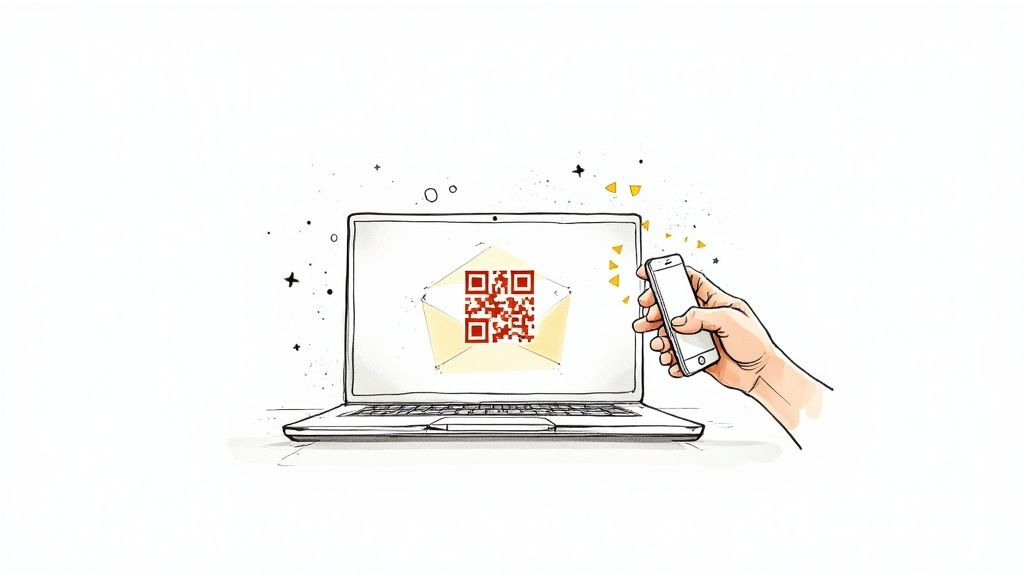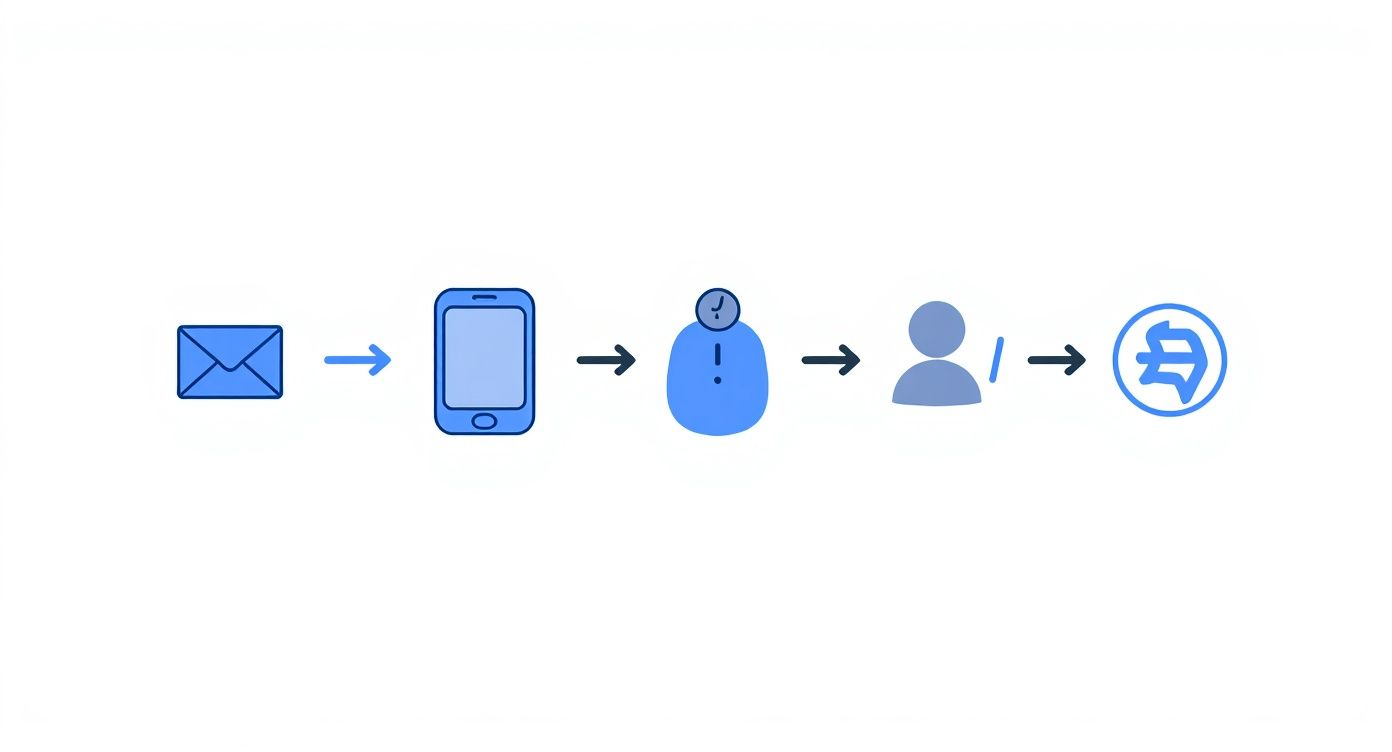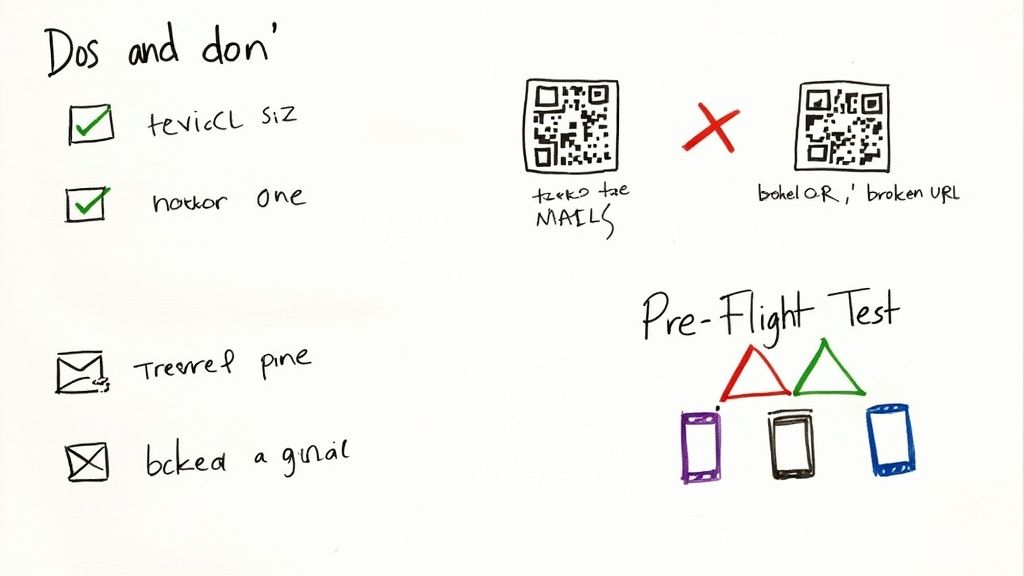November 17, 2025

Putting a QR code in an email is a genuinely clever way to close the loop between your digital message and a real-world action. This simple piece of tech can instantly turn a static email into a live, interactive experience.
Think about it: this is perfect for speeding up event check-ins, sharing exclusive content, or just making life easier for your members. It makes your emails less about reading and more about doing.
Just about everyone has a smartphone in their pocket these days, making the humble QR code a surprisingly powerful tool. It’s a familiar sight, and it creates a super smooth path from someone's inbox to whatever you want them to do next. No more asking them to type in a long, clunky URL or find something on your website. Just point, scan, and go.
This kind of direct interaction is a game-changer for member-based organizations and anyone running events. Remember the last time you were stuck at a check-in desk with a clipboard and a long line? Now, picture sending every attendee a unique QR code in their confirmation email. They show up, you scan it, and they're in. Simple, fast, and professional.
The real magic of a QR code in an email is how it connects two completely different environments so effortlessly. This connection isn't just a novelty; it drives real results that are far more meaningful than a simple email open or click.
You’re not trying to invent new behavior here; you’re tapping into something people already do. The data is pretty staggering: by 2025, the number of global scans hit an incredible 41.77 million—that’s a 433% jump from 2020. With 4.88 billion smartphone users out there, this is a channel you can count on. If you're curious, you can find more stats on QR code adoption rates that really show how mainstream this has become.
The Big Idea: This isn't about adding a cool graphic to your email for the sake of it. It’s about removing friction for your members and creating a modern, efficient experience they'll actually appreciate.
By building scannable tech into your campaigns, you’re not just hopping on a trend. You're using a proven tool to make your members' lives easier and hit your own goals. For more inspiration, check out these event marketing ideas that can be supercharged with QR codes. It’s all about making every email work a little harder.
Let’s be honest, a generic black-and-white QR code looks clunky and out of place. It doesn't exactly scream "professional" or build trust. A truly effective QR code should feel like a seamless part of your email design, not something you just dropped in.
The first thing you need to decide is what you want the code to do. This all comes down to the data type you pick when generating it. Are you sending people to an event landing page? A simple URL link is all you need. Want to give a guest speaker an easy way to share their info? A vCard data type will let attendees add them as a contact with a single scan.
The whole point is to make life easier for your audience. They get the email, scan the code with their phone, and it instantly triggers an action.

It’s a simple, direct bridge between your digital message and a real-world action.
Once you've got the function sorted, the fun part begins: customization. This is where you can make the QR code truly yours. It's a small detail, but getting it right is crucial for aligning the code with your visual identity, which is a cornerstone of great branding in events.
Here’s how to customize your QR code without messing up its scannability:
Stick with PNG Format: Always, always export your QR code as a PNG file. It handles sharp lines and transparency perfectly, which means it will look crisp and scan reliably on any device. JPEGs can create fuzzy artifacts around the code, leading to scan errors.
Add Your Logo: Most good QR code generators let you pop a logo right in the middle. This is a huge trust signal. When people see your logo, they immediately know the code is from you and feel much safer scanning it.
Be Smart with Brand Colors: You can definitely swap out the black for one of your brand colors, but contrast is everything. A pale yellow code on a white background is a recipe for disaster. Always use a dark, bold color for the code itself and place it on a clean, light background.
Pro Tip: Don't just trust what you see on your screen. Before sending the email, print the QR code out and try scanning it. Test it on different phones in both dim and bright lighting. A code that looks fine on your monitor might be completely unreadable in the real world.
You can't just drop a QR code into an email and expect people to know what to do with it. You have to guide them. The final, critical touch is to wrap your code in a simple frame with a clear, direct call-to-action (CTA).
This tiny addition removes all the guesswork and can make a massive difference in your scan rates.
Instead of a naked image, try something like:
This simple text tells your audience exactly what to do and what will happen when they do it. It turns a static image into an interactive instruction. Combine this with your logo and high-contrast brand colors, and you’ve got a QR code that not only works perfectly but also reinforces your brand.
So you've designed the perfect, on-brand QR code for your next event. That's the easy part. The real challenge? Getting it into your members' inboxes without tripping every spam filter along the way.
Let’s get one thing straight: never, ever attach the QR code image file directly to your email.
Email providers are incredibly wary of attachments from bulk senders—it’s a massive red flag. Attaching the image skyrockets your email's spam score, practically guaranteeing it lands in junk. It’s an old-school move that modern email systems just don't trust.
The right way to include a QR code in an email is to embed it as a hosted image. This just means you upload the image file (your PNG) to a reliable spot online. This could be your website’s media library, a cloud storage service like Amazon S3, or even your email marketing platform's own image hosting.
Once it's uploaded, you'll get a direct link to that image. You then simply pop that image URL into your email template. When your member opens the email, their client just fetches the image from that web address. Simple.
This isn't just a workaround; it's the professional standard. Here's why:
Getting the image to show up is only half the battle. What happens when it doesn't? Many people block images in their email clients by default, and members using screen readers can't see them at all.
This is why ALT text (alternative text) is absolutely critical. It’s a short description that displays when the image can't, telling the user what they're supposed to be seeing. Without it, they just get a broken image icon and a lot of confusion.
Don't just write "QR code" and call it a day. Good ALT text is descriptive and tells the user what to do. Something like, "Scan this QR code to check in for the Annual Gala" is far more helpful.
Taking a few seconds to add clear ALT text makes your email more inclusive and ensures your call to action is understood by everyone, image or no image. It’s a small detail that makes a big difference in how professional and thoughtful your communications feel.
Properly embedding QR codes with good ALT text is a non-negotiable step for creating a smooth experience for your entire audience.
So, you've sent an email with a QR code. Great. But did it actually do anything? Just looking at your email open rate won't tell you the whole story. This is where dynamic QR codes really earn their keep, turning your campaign from a shot in the dark into a source of real, hard data.
Unlike static codes, which are a one-and-done deal, dynamic codes let you see exactly how people are interacting with them as it happens. We're not talking about vanity metrics here; this is about understanding actual behavior and proving your work is paying off.
When you use a dynamic QR code in an email, you're essentially adding an analytics layer to your campaign. The data tells a story, connecting your digital message to a real-world action—like a member walking through the door of your event.
You can suddenly see all sorts of useful information:
This level of detail is a game-changer. For an event check-in, you can pinpoint exactly how many attendees came directly from a specific email campaign. That’s the kind of insight you need to justify your efforts and make smarter decisions next time. You can learn more about how to evaluate these results by exploring different community engagement metrics.
Raw numbers are nice, but they're only truly useful when you tie them back to what you were trying to achieve in the first place. If your goal was to get more webinar registrations, the number of scans on that specific registration link is your most important metric.
The Takeaway: The goal isn't just to get scans; it's to drive a specific outcome. By using a unique dynamic QR code for each email campaign, you can isolate which messages are most effective at converting readers into participants.
This data is especially powerful when you consider how popular QR codes have become. The United States, for instance, has consistently led in QR code usage, accounting for 43.9% of global scans in 2023. People are comfortable using them, which means they’re a reliable tool for your campaigns. To dive deeper into this trend, discover more insights about QR code usage by country.
To really understand what's working, you need to combine QR code analytics with broader strategies for maximum engagement in email marketing campaigns. Things like A/B testing your subject lines or calls to action, combined with your scan data, will give you a complete picture of what your audience responds to, letting you refine and improve with every email you send.
Let's move past the theory. This is where using a QR code in an email really starts to shine.
Picture this: you send an event confirmation to a member. Embedded right in the email is a personalized QR code. When they show up, they just flash their phone, you scan it, and they're instantly checked in.
That single action gets rid of paper lists, long lines, and painful manual data entry. It creates a modern, smooth experience from the get-go. It’s a small tweak that makes your organization look incredibly professional and saves your team a massive administrative headache.
The check-in process is really just the starting line. QR codes can guide your members through all sorts of valuable actions, turning a simple email into a powerful engagement tool.
Don’t just think about getting people in the door. A QR code can do so much more before, during, and after an event:
Here’s a look at how the GroupOS platform brings these kinds of seamless event and community management workflows together in one place.

As you can see, an integrated tool can handle everything from ticketing to member engagement without you having to jump between different systems.
Putting a QR code in an email is about more than just convenience; it’s a smart way to drive engagement and deliver real value to your community. These little scannable squares can unlock unique opportunities that genuinely strengthen the bond with your members.
A QR code isn't just a shortcut; it's a bridge to an immediate, interactive experience. When used thoughtfully, it shows your members that you value their time and are committed to providing a modern, frictionless journey.
For instance, you could partner with a coffee shop near your conference venue and pop a QR code in an email for a special discount. Or, use a code to give loyal members early-bird access to register for next year's big event. These simple applications make your members feel like true insiders.
We actually take a much deeper look at how this transforms the entire process in our guide to QR code event registration. By weaving these practical ideas into your strategy, your email campaigns stop being simple announcements and become dynamic tools that build real loyalty and boost participation.

A broken or sketchy-looking QR code can do more harm than good. It not only kills the user experience but can also make your organization look unprofessional and erode the trust you've built with your members. Getting your QR code in an email right means knowing what to watch out for.
It's surprisingly easy to mess this up. I’ve seen codes that are too small to scan on a phone screen or ones that use low-contrast brand colors, like a trendy light gray on a white background, which simply won't work in the real world.
But the most frustrating mistake? A dead link. Imagine a member eagerly trying to check into your event, only to be met with a 404 error. That's a terrible first impression before they've even walked through the door.
In an era of endless phishing scams, people are more skeptical than ever. A nasty new trend called “quishing” (QR code phishing) uses malicious codes to trick users into visiting fake websites that steal their login details. Because the destination URL is hidden behind the code, it's a perfect vehicle for scammers.
This is where you have to be vigilant about building trust. First and foremost, always make sure your QR codes point to secure websites using HTTPS. That’s the bare minimum and a clear signal that you take member security seriously.
Key Takeaway: Don't make people guess. Add a simple, clear label right next to the code. Something like "Scan here for your event ticket" or "Scan to view the full agenda" removes all ambiguity and reassures your members about where they're going.
This focus on security should extend beyond just the QR code itself. Always stick to essential email security best practices to protect your members and your organization's reputation.
Never, ever assume your QR code will just work. Different email clients, apps, and devices can render images in weird ways. Before you hit "send" on a big campaign, you need to run it through a solid testing process.
Here’s a quick checklist I run through before any email with a QR code goes out:
This little routine might feel like a chore, but it’s the best way to catch an embarrassing mistake before it reaches hundreds or thousands of your members. A well-tested QR code in an email is a tool that works, making life easier for your community and reflecting well on your brand.
Even the best-laid plans can hit a few snags. When you're working with QR codes in your emails, a few questions tend to come up again and again. Let's get them answered now so you can sidestep any potential issues and feel confident hitting "send."
Yes, they will. Pretty much any modern email client, from Gmail to Outlook, treats a QR code just like any other image. Think of it as a standard PNG or JPG file.
The trick is to embed the image correctly. You need to host it on a web server and link to it in your HTML, not attach it directly to the email. Attaching files is a classic spam filter trigger. Also, don't forget to add descriptive ALT text. That way, if someone has images blocked, they'll still know what the QR code is for.
I always recommend starting with 300x300 pixels. This seems to be the sweet spot. It's big enough for a phone camera to scan easily right off a computer screen, but it won't overwhelm the rest of your email design.
My Go-To Sanity Check: Before any campaign goes out, I test it myself. I send a draft to my own inbox, open it on my laptop, and try to scan the QR code with my phone. If it works instantly, I know the size is good.
Out of the box, no. A standard dynamic QR code can tell you how many people scanned it, but not who they are. To track individual members by name, you'd need a more sophisticated system that generates a completely unique QR code for each person on your mailing list.
However, you can still get incredibly useful data. By creating different dynamic QR codes for separate campaigns, you can see which one performed better. For instance, you could learn that your "Early Bird Discount" email got way more scans than your "Last Chance to Register" email, which is fantastic insight for planning your next event.
For emails, a mobile-friendly webpage is almost always the right answer. It's the path of least resistance. Everyone has a web browser on their phone, but not everyone will have your specific app installed.
Forcing someone to stop, go to the app store, and download something new just to use your QR code is a huge ask. That extra step is where you lose people. Sending them straight to a webpage to register or get information keeps the experience seamless and gets you much higher conversion rates.
Ready to streamline your event check-ins and boost member engagement? GroupOS provides an all-in-one platform with built-in QR code functionality, seamless ticketing, and powerful communication tools. Start your free trial today and see how easy it can be.


